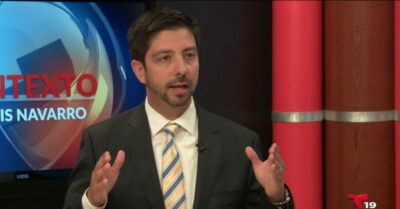Innovation and STEM Fields
For America to compete in the 21st century, we need a robust innovation economy—which requires a workforce skilled in the science, technology, engineering, and math (or STEM) fields. Yet American students are not entering those industries in sufficient numbers, and the United States is projected to face a shortage of one million STEM workers by 2022.1 Foreign-born students frequently gravitate towards STEM disciplines, making up roughly one out of every three individuals earning graduate-level STEM degrees each year. Our broken visa system, however, makes it difficult for many of them to stay after graduation—a reality that hurts the ability of our employers to expand and create more opportunity for American workers. 1 President’s Council of Advisors on Science and Technology, "Engage to Excel: Producing 1 million Additional College Graduates with Degrees in Science, Technology, Engineering, and Mathematics," February 2012. Available online.

This Venerated Engineer Says Embracing Skilled Immigrants Will Make America Great
Ram Bhatia was living in Montreal when a U.S. headhunter called him, saying, “We can’t find anyone in the United States.” The headhunter had spent a year looking for an engineer who could help a Wisconsin firm develop linear electrical motors. Bhatia, who is originally from India, had done graduate… Read More

College Dean Worries that Not Enough U.S. Students Pursuing STEM
As a child, Manoj Babu used to say he lived in two different worlds. There was America, where he attended school and had friends in Southeast Texas. And there was India, the culture that saturated life behind the doors of his house. His mother, a nurse, had come… Read More

Without Immigration Reform, This Dean Worries Manufacturers Won’t have the Technical Workers they Need
As Indian immigrants growing up in East Texas, Manoj Babu and his sister were encouraged to pursue careers in science and math. Forget sports or music. They attended STEM (science, technology, engineering, and math) competitions. In fact, Babu jokes that he may have actually disappointed his father by becoming… Read More

CEO of Indianapolis Power and Light Believes Immigrants Power State Economy
After graduating from university in Puerto Rico, Rafael Sanchez and his wife sold their belongings and moved to Fort Wayne, Indiana, to study law – only to realize that Fort Wayne didn’t have a law school. “When you’re young and stupid, your only due diligence is, ‘Where do we know… Read More

CEO Barry Zhang Says High Tech Manufacturing Companies Depend on Machine Operators from Abroad
Barry Zhang already had two degrees when he came to the United States from China to study at Princeton University. There he earned a PhD in mechanical and aerospace engineering. His wife’s U.S. employer sponsored her for a green card, and Zhang gained residency as her dependent around the time… Read More

Robotics Expert Is Recruited to the U.S., but Visa Prohibits His Wife From Working
Despite being on track to become a judge in her native England, attorney Michelle Garrod decided to forego her own professional advancement to support her husband, Michael, when he was recruited to be the Chief Technology Officer (CTO) for BlackDog Robotics, a division of the American company NPC… Read More

Educator Says that Without Immigration Reform Kentucky Schools Can’t Produce Enough Technical Workers
Dr. Ty Handy has been an educator for more than 16 years, during which time he’s worked with many immigrants and international students. As current president of Jefferson Community and Technical College in Louisville, located in Kentucky’s 3rd Congressional District, he oversees an annual operating budget of almost $50 million. Read More

Head of University of Louisiana Computer Science Department: ‘Our Strength is in Our Diversity’
Magdy Bayoumi, director of the Center for Advanced Computer Studies and head of the Computer Science department at the University of Louisiana at Lafayette, was born and raised in Cairo, Egypt—but he always knew he’d to move to America one day. “Since I was in high school, my plan was… Read More

Yes, Even the U.S. Forest Service Needs Immigrant Talent
When freelance software developer Ana Monzon was in the process of moving to Wyoming from Guatemala City in the midst of the recession, she knew finding a job would not be a problem. “My skill set is a big demand in this country,” says Monzon. “I was able to get… Read More

Canadian Software Engineer Says U.S. Turns Away the Very Tech Talent it Needs
Helen Fu fell in the love with the Bay Area tech world when she participated in summer internships at Facebook and Palantir. When Palantir offered her a job after college, Fu, a Canadian student, entered the visa lottery that allows skilled workers to fill jobs in specialty occupations. She did… Read More
Outsize Role in the Workforce
Immigrants punch above their weight class in the STEM fields, making up far larger portions of the STEM workforce than they do the U.S. population overall. This dynamic is particularly pronounced in several states. In New Jersey, for instance, immigrants make up almost two out of every five STEM workers, while accounting for only one in five of the state’s residents.
States with the Highest Share of Foreign-Born STEM Workers, 2014
Labor Shortages
In recent years, many U.S. employers have struggled to find enough STEM workers. This lack of manpower has real consequences for the economy—making it difficult for firms to expand and create jobs for American workers at all skill levels. In several specialized fields, like physical science and software development, the unemployment rates of U.S.-born STEM workers are particularly low, indicating there are simply not enough U.S.-born workers to meet the needs of employers.
Take a look at our latest research about the shortage of STEM workers.
U.S. Citizen Unemployment Rates in STEM Fields Most Heavily Reliant on Immigrant STEM Workers, 2014
Earning STEM Degrees
International students make up a large share of STEM graduate students. In 2014, more than a quarter of STEM master’s degrees and more than a third of STEM Ph.D. degrees went to students in the country on temporary visas. Meanwhile, the number of American citizen and permanent resident students pursuing graduate degrees in science and engineering fields actually fell by 6.3 percent between 2010 and 2013.2 Our broken immigration system means that many of these international students will struggle to remain in the country after graduation, despite employers needing them.
Sources:
2 National Science Foundation, Science and Engineering Indicators, 2016, Appendix Table 2-25. Available online.
Share of Ph.D.'s in Selected Fields Going to Students on Temporary Visas, 2014
States Graduating the Most STEM Students on Temporary Visas, 2014
States Needing STEM Workers
While every state was short STEM workers in 2015, the shortage was particularly acute in North Dakota and South Dakota, where employers listed 87 and 71 STEM positions, respectively, for each unemployed STEM worker. These are gaps that immigrants could help fill. In South Dakota, for instance, immigrants made up just three percent of all STEM workers in 2015, one of the lowest shares in the country.
States with Greatest Shortages of STEM Workers, 2014
Creating U.S. Jobs
Rather than reduce the number of jobs available to American workers, foreign-born STEM graduates often create additional jobs for U.S.-born workers. Research shows that when a state gains 100 foreign-born STEM workers with graduate-level training from a U.S. school, an average of 262 jobs are created for U.S.-born workers there in the seven years that follow.3 More specifically, the temporary visa (H-1B) program for high-skilled workers is also linked to job creation for American workers and economic growth. However, the current system fails not only to provide visas that companies need to grow, but also to protect against fraud and abuse.
Sources:
3 Madeline Zavodny, “Immigration and American Jobs,” The Partnership for a New American Economy and the American Enterprise Institute, 2011. Available online.
States that Stand to Gain the Most from Retaining More Foreign-Born STEM Graduates
The Impact of our Broken Immigration System
Since the recession, some of the most robust growth in high-wage, American jobs has occurred in cities. The high-tech companies fueling this growth cannot succeed and grow, however, without qualified STEM professionals—a group that can be difficult to find. An annual cap on the number of available green cards and H-1B visas hinders efforts to hire immigrant STEM professionals when no American workers are available. At right, we explore how the H-1B requests for computer-related workers that did not make it through the 2007 and 2008 H-1B visa lotteries impacted wages and the number of jobs available for U.S.-born tech workers in the two years that followed.4
Sources:
4 Partnership for a New American Economy, “Closing Economic Windows: How H-1B Visa Denials Cost U.S.-Born Tech Workers Jobs and Wages During the Great Recession," June 4, 2014. Available online.
Metropolitan Areas Hurt Most by 2007 and 2008 Denials in the H-1B Lottery
Driving Innovation
International STEM students and graduates are behind some of America’s most impressive innovations, from artificial skin to moldable metal. Studies show that immigrants with an advanced degree are three times more likely than U.S.-born graduate degree holders to file a patent. When universities increase their share of international students, they often receive more patents—boosting revenue and creating more opportunities for all students.
Share of Patents Awarded to Top Patent Producing Research Universities with at Least One Foreign-Born Inventor, 2011
Make a contribution
Make a direct impact on the lives of immigrants.
